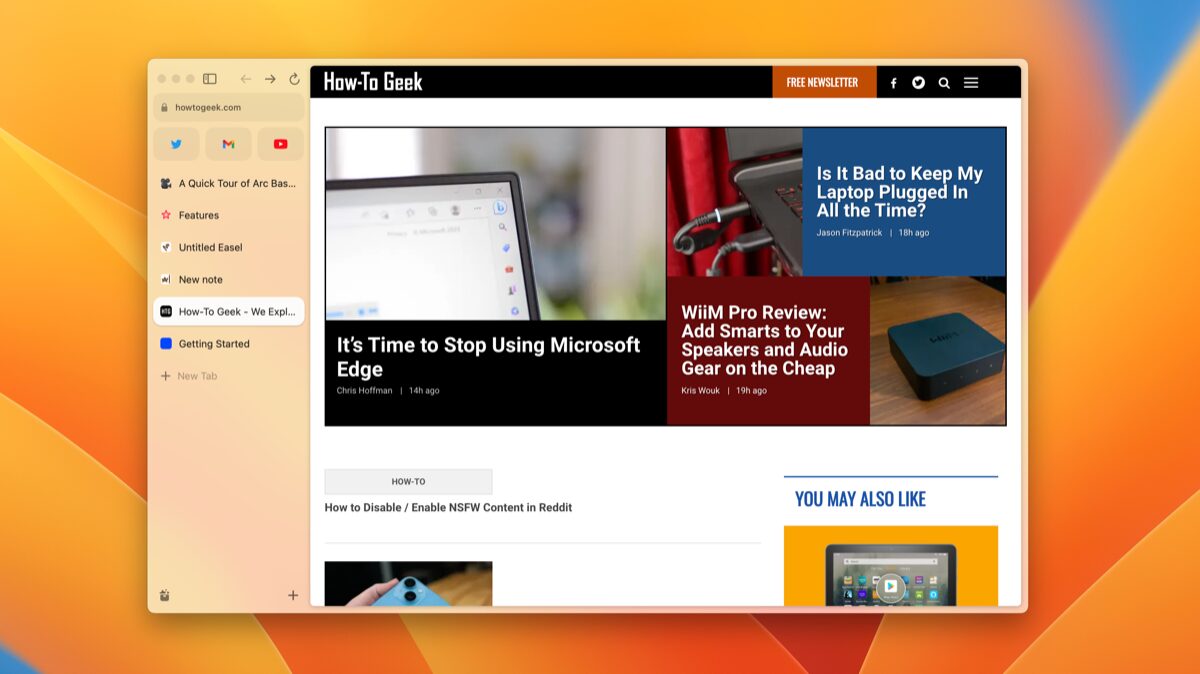Samsung Galaxy Watch 7 Review: A Great Smartwatch With a Big Asterisk
Android
Key Takeaways
-
The Galaxy Watch 7 maintains Samsung’s strong design aesthetic with minor refinements. The new processor significantly improves performance, making it the fastest Galaxy Watch yet.
- Samsung continues to lead in health and fitness tracking with advanced features like sleep apnea detection, AGEs index tracking, and the informative Energy Score.
- A potential deal-breaker is battery life issues affecting some users (including our model). Samsung has acknowledged the problem and is working on a fix.
When it comes to Galaxy Watches, Samsung has found a recipe it likes, and it’s sticking with it. The Galaxy Watch 7 is the result of that same recipe, but there are some exciting new ingredients this time around. Unfortunately, there’s one nasty flavor that could ruin the entire dish if it’s not fixed. (Samsung says that the software bug reducing battery life will be addressed. When, and if, that happens, the product rating for this review will dramatically increase.)

Samsung Galaxy Watch 7
The Samsung Galaxy Watch 7 is Samsung’s entry-level smartwatch for 2024. It resembles the Galaxy Watch 6 but features an enhanced Exynos W1000 chipset, promising significantly improved battery life and performance.
- Excellent performance with upgraded processor
- Premium build quality and elegant design
- New health and fitness features
- Beautiful display with small bezels
- Battery life bug makes it hard to get through a single day
Price & Availability
The Galaxy Watch 7 is available in two sizes: 40mm and 44mm. The 40mm model is available in green and cream, while the 44mm model is available in green and silver. They are available now starting at $299.99 and $329.99 respectively. Add an extra $50 if you opt for the 4G LTE version.
The model seen in this review is Silver, 44mm, Wi-Fi only, with Silver Sport band.
The Tiniest of Design Changes
It’s hard to believe that Samsung has been reusing the same design for its baseline Galaxy Watch series since the Galaxy Watch 4. I didn’t notice it immediately, but the Galaxy Watch 7 actually changes it up every so slightly.
Since 2021, the watches have featured a design with metallic brackets that wrap around the sides of a black glass cylinder, leaving the watch band ends open. It’s a pretty cool look that I’ve always liked. This year, however, those metallic brackets wrap all the way around, fully encasing all sides of the watch. Admittedly, this is a very minor change, but it is a change, nonetheless.
I think I prefer the older style—it was a little more unique—but the Galaxy Watch 7 is still a very stylish smartwatch. The minimalist design works well with a sporty silicone band or a more formal leather band. That’s what I look for in a smartwatch—something I can wear for any occasion.
Like every Galaxy Watch, the Watch 7 has two physical buttons on the right side: a power/home button and a back button. Regardless of body color, the home button has an orange accent. The buttons feel nice, and the home button can be customized to launch apps with a double press or a long press. A nice trick is to use the shortcuts for Google Assistant and Google Wallet.
The Watch 7 is equipped with a Super AMOLED panel that is bright, sharp, and colorful. The big update last year was screen size, and the Watch 7 retains the same displays. That’s 1.3 inches on the 40mm model and 1.5 inches on the 44mm model. The larger display and slimmer bezels are great, and it’s one of the main reasons I may upgrade from my Galaxy Watch 5.
Overall, I have no complaints about the design or build of the Galaxy Watch 7. I have to hand it to Samsung for coming up with a nice design and sticking with it. The company even managed to come up with a better watch band quick-release mechanism that still allows for standard bands. If I had to come up with a gripe, it would be that the 40mm model is not available in silver—only the 44mm model comes in that color.
One UI is Still a Great Smartwatch UI
The Galaxy Watch 7 ships with One UI 6 Watch on top of Wear OS 5. Right up front, it’s worth noting that almost all of the software features will eventually roll out to the Galaxy Watch 6, Watch 5, etc. However, I’m not sure there’s a whole lot to get excited about.
During the initial setup, it was clear that Samsung wants people to use a couple of gestures. The first is a double-pinch with your pointer finger and thumb to interact with the screen. In my testing, there were very few opportunities to put this gesture to use. The most useful was the ability to play or pause music and pause and then restart workouts. The gesture worked well when I actually used it, but that didn’t happen very often.
The second gesture is like knocking on a door with your fist twice. This gesture can be mapped to a number of things, like apps, the flashlight, and workouts. I found the knock gesture to be much less reliable than the pinch gesture, and the screen has to be on in order to use it.
Perhaps the most significant thing to say about the software is it feels faster, but that’s thanks to the Exynos W1000 chip. Samsung said it’s “3x faster,” but I wouldn’t go that far. That being said, the Galaxy Watch 7 is certainly the fastest Galaxy Watch I’ve used. I almost always notice a smartwatch struggle during the initial setup when a bunch of stuff is happening at once—not on the Galaxy Watch 7.
One UI 6 Watch also comes with a few visual updates, but nothing major. There are, of course, new watch faces as well. “Spatial Number” is the clear winner here. “Ultra Info Board” is way too messy, and “Simple Digital” looks like someone stopped designing it halfway through.
New Health and Fitness Features Further Samsung’s Lead
It’s been a while since Samsung revamped its health sensors on the main Galaxy Watch series. This year, the Galaxy Watch 7 has more LEDs underneath—for tracking heart rate and blood oxygen—and an upgraded BioActive sensor.
Another addition is the “Energy Score,” which is a similar concept as Fitbit’s “Readiness” score. Essentially, it takes a few metrics into consideration—physical activity, sleeping heart rate, sleeping heart rate variability, and sleep scores—and then tells you what to expect for your energy levels for the day.
In the past, I’ve complained about health services not doing enough with the data they collect, and the Energy Score is a good example of what can be done with it. It’s genuinely helpful to have a tangible metric so you can say, “okay, I should probably take it easy today,” or “today would be a good time for my long run of the week.”
Related to the Energy Score, the Galaxy Watch 7 features improved sleep analysis. It’s the first Android wearable with FDA-approved sleep apnea detection. After two nights of sleep, it can tell you if you should seek further medical analysis or not. You do need to manually start the sleep apnea detection each night—it’s not one of the regular sleep tracking features.
The last new feature is Advanced Glycation End Products (AGEs) Index tracking. That’s used to measure your metabolic health and biological aging. As you can probably tell, there’s a lot of health and fitness stuff happening in the Galaxy Watch 7. I’ve been a fan of Samsung’s health and fitness software for a while now and it just seems to be getting better.
The story is night and day compared to what Google is doing with Fitbit on the Pixel Watch series. When I use those watches, I feel like I’m being held back. But with a Samsung Galaxy Watch, I have a smorgasbord of data and features at my disposal. The Galaxy Watch 7 or Watch Ultra is the watch to get if you’re an Android user who wants the best health and fitness capabilities.
A Nasty Battery Bug Ruins the Experience
Now, for some bad news. There appears to be a pretty big discrepancy in battery life for Galaxy Watch 7 owners. Sadly, I happened to be in the boat of people experiencing pretty terrible battery performance.
One day, the low battery notification popped up around 9:30PM. I thought that was strange. I’ve used Galaxy watches for a long time and they always easily get me through one day. I thought maybe it didn’t fully charge overnight. But then the same thing happened the following night, and I confirmed it was at 100% in the morning.
What was even more concerning was that I didn’t have the always-on display enabled. It turns out I’m not alone in my experience. Other people on Reddit have reported similar findings, while battery life is totally fine for others. This leads me to believe there’s some sort of bug causing these results. Battery life can’t be this bad; if it is, everyone would be complaining.
However, as it is—at least for me—this was easily the worst battery life I’ve had with a smartwatch. Hopefully, Samsung will address the issue in the future.
Samsung did indeed confirm that a bug was causing bad battery life on some Galaxy Watch 7 models. On July 26, 2024, a
product team member said
, “We will soon distribute S[oft]W[are] that fixes the issue.”
The Competition in Smartwatches
Talking about “competition” with smartwatches is always an interesting topic. Because it’s not like you can go buy any ‘ol smartwatch and get the same experience regardless of your phone. If you’re an iPhone user, there is no competition. Your choice is an Apple Watch, and you’re probably not reading this.
However, for Android users, it’s a little more open-ended. The top competitors are the Samsung Galaxy Watch 7 and the Pixel Watch 2 or upcoming Pixel Watch 3. I was pleased with Google’s improvements in the Pixel Watch 2, but it was still far behind the Galaxy Watch. I expect the same from the Pixel Watch 3 versus the Galaxy Watch 7.
Samsung and Google have very different approaches to their phone and watches. Google is all about simplicity and minimalism, while Samsung is not afraid to give you every feature you could imagine and more. I prefer Google’s approach when it comes to phones, but it makes me feel very restricted on a watch, especially if you do a lot of health and fitness tracking.
There’s also the Galaxy Watch Ultra to consider. The Ultra model adds a few more “hardcore” activities to its arsenal, such as rock climbing and trekking, and better water resistance for water sports. It also has a bigger battery (590mAh vs 425mAh on the Watch 7 44mm). However, it does not have a bigger screen or a better processor, and it costs a whopping $650. The Watch 7 is the better choice for most people.
Should You Buy the Samsung Galaxy Watch 7?
I have to admit this is a more complicated recommendation than most of my reviews. Last year, I reviewed the Galaxy Watch 6 Classic and called it “low effort greatness.” It didn’t seem like Samsung tried very hard, yet it made an excellent device. There’s a bit of that feel with the Galaxy Watch 7, too.
My usual daily smartwatch is the Galaxy Watch 5–has been for nearly two years–and I’d be lying if I said the Galaxy Watch 7 felt like a significantly better device. But that’s more of a testament to how solid Samsung’s watches have been for the last few years than an indictment of the Galaxy Watch 7.
In many ways, the Galaxy Watch 7 is the best smartwatch Samsung has ever made. It’s pretty close to being a perfect device. The display is great, and it takes up nearly the entire watch face. It’s fast. The health and fitness sensors and software are right up there with the Apple Watch. The design is understated and adaptable. However, there’s one big black mark: battery life.
Now, I was pretty confident that the battery life I experienced was not normal. I’ve never used a smartwatch with battery life this bad, and it didn’t seem to be happening to all users. Thankfully, Samsung confirmed it was indeed a bug and said a software update will address the issue. That makes my job a bit easier, but I still can’t just assume the problem will be completely resolved without seeing it for myself.
If you’re interested in the Galaxy Watch 7, the best thing to do is wait and see. Samsung Galaxy watches generally have good, if not great, battery life. Should Samsung fix the issue with a software update, this is an excellent device for Android users. With that problem out of the way, I’d have trouble finding any flaws in the Galaxy Watch 7.

Samsung Galaxy Watch 7
The Samsung Galaxy Watch 7 is Samsung’s entry-level smartwatch for 2024. It resembles the Galaxy Watch 6 but features an enhanced Exynos W1000 chipset, promising significantly improved battery life and performance.


























